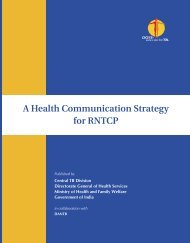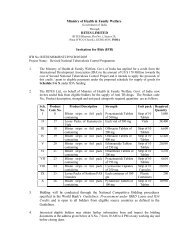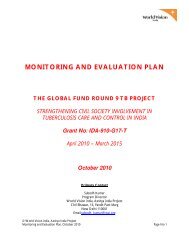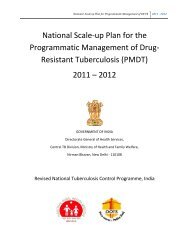RNTCP Annual Report 2012 - TBC India
RNTCP Annual Report 2012 - TBC India
RNTCP Annual Report 2012 - TBC India
Create successful ePaper yourself
Turn your PDF publications into a flip-book with our unique Google optimized e-Paper software.
Burden of TB-HIV:<br />
TB and HIV act in deadly synergy. HIV infection increases<br />
the risk of TB infection on exposure, progression from<br />
latent infection to active TB, risk of death if not timely<br />
treated for both TB and HIV and risk of recurrence<br />
even if successfully treated. Correspondingly, TB is the<br />
most common opportunistic infection and cause of<br />
mortality among people living with HIV (PLHIV),<br />
difficult to diagnose and treat owing to challenges related<br />
to co-morbidity, pill burden, co-toxicity and drug<br />
interactions. Though only 5% of TB patients are HIVinfected,<br />
in absolute terms it ranks 2nd in the world and<br />
accounts for about 10% of the global burden of HIVassociated<br />
TB. This coupled with heterogenous<br />
distribution within country is a challenge for joint delivery<br />
of integrated services. National and international studies<br />
indicate that an integrated approach to TB and HIV<br />
services can be extremely effective in managing the<br />
epidemic. A modelling study by Williams et al predicts<br />
that that <strong>RNTCP</strong> should be able to reverse the increase<br />
in TB burden due to HIV, but to reduce mortality by<br />
50% or more by 2015, universal access to coordinated<br />
TB and HIV care is essential. Studies also indicate that<br />
emphasis needs to be on early diagnosis linked to TB<br />
and HIV treatment.<br />
Global estimation of burden of HIV positive incident<br />
TB cases is 10,00,000 (11,00,000-12,00,000) while the<br />
estimates of HIV positive incident TB cases in <strong>India</strong> is<br />
75,000 (1,10,000 - 1,60,000). As per WHO's Global TB<br />
<strong>Report</strong> of 2011, HIV prevalence amongst incident TB<br />
cases is estimated to be 3.3% (5%-7.1%).<br />
Burden of paediatric TB in the country:<br />
The actual burden of pediatric TB is not known due to<br />
diagnostic difficulties but has been assumed that 10% of<br />
total TB load is found in children. Globally, about 1 million<br />
cases of pediatric TB are estimated to occur every year<br />
accounting for 10-15% of all TB; with more than 100,000<br />
estimated deaths every year, it is one of the top 10 causes<br />
of childhood mortality. Though MDR-TB and XDR-<br />
TB is documented among pediatric age group, there are<br />
no estimates of overall burden, chiefly because of<br />
diagnostic difficulties and exclusion of children in most<br />
of the drug resistance surveys.<br />
Socio-economic impact:<br />
Tuberculosis Epidemiology - <strong>India</strong><br />
11<br />
Besides the disease burden, TB also causes an enormous<br />
socio-economic burden to <strong>India</strong>. TB primarily affects<br />
people in their most productive years of life with important<br />
socio-economic consequences for the household and the<br />
disease is even more common among the poorest and<br />
marginalized sections of the community. Almost 70% of<br />
TB patients are aged between the ages of 15 and 54 years<br />
of age. While two thirds of the cases are male, TB takes a<br />
disproportionately larger toll among young females, with<br />
more than 50% of female cases occurring before 34 years<br />
of age. The direct and indirect cost of TB to <strong>India</strong> amounts<br />
to an estimated $23.7 billion annually. Studies suggest that<br />
on an average 3 to 4 months of work time is lost as result<br />
of TB, resulting in an average lost potential earning of 20-<br />
30% of the annual household income. This leads to<br />
increased debt burden, particularly for the poor and<br />
marginalized sections of the population. The vast majority<br />
(more than 90%) of the economic burden of TB in <strong>India</strong><br />
is caused by the loss of life rather than by morbidity. This<br />
is due to the fact that TB mortality incurs a greater loss in<br />
the number of life-years per event than does TB morbidity<br />
- despite the fact that there are many more prevalent cases<br />
than deaths. A study on the economic impact of scaling<br />
up of <strong>RNTCP</strong> in <strong>India</strong> in 2008 shows that on average<br />
each TB case incurs an economic burden of around US$<br />
12,235 and a health burden of around 4.1 DALYs.<br />
Similarly, a death from TB in <strong>India</strong> incurs an average burden<br />
of around US$ 67,305 and around 21.3 DALYs. A total<br />
of 6.3 million patients have been treated under the <strong>RNTCP</strong><br />
from 1997-2006. This has led to a total health benefit of<br />
29.2 million DALYs gained including a total of 1.3 million<br />
deaths averted. In 2006, the health burden of TB in <strong>India</strong><br />
would have risen to around 14.4 million DALYs or have<br />
been 1.8 times higher in the absence of the programme.<br />
The <strong>RNTCP</strong> has also led to a gain of US$ 88.1 billion in<br />
economic wellbeing over the scale-up period. In 2006, the<br />
gain in economic wellbeing is estimated at US$ 19.7 billion<br />
per annum - equivalent on a population basis to US$ 17.1<br />
per capita. In terms of TB patients, each case treated under<br />
DOTS in <strong>India</strong> results in an average gain to patients of 4.6<br />
DALYs and US$ 13,935 in economic wellbeing.






